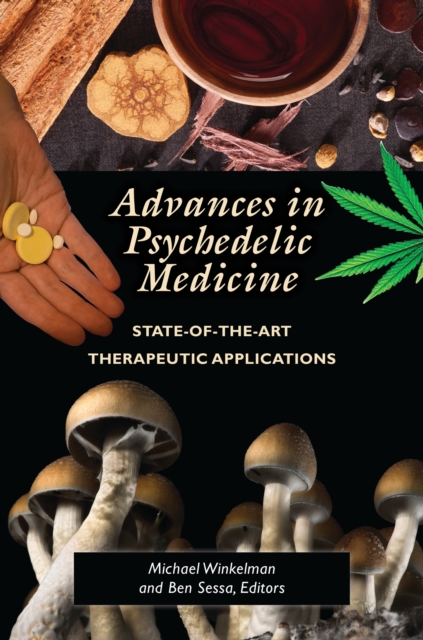“There is a world beyond ours, a world that is far away, nearby and invisible. And there is where God lives, where the dead live, the spirits and the saints, a world where everything has already happened and everything is known. This world talks. It has a language of its own. I report what it says. The sacred mushroom takes me by the hand and brings me to the world where everything is known. It is they, the sacred mushrooms, that speak in a way I can understand. I ask them and they answer me. When I return from the trip that I have taken with them, I tell what they have told me and what they have shown me.” – Maria Sabinahttp://realitysandwich.com/323749/mazatec-mushroom-usage-notes-on-approach-setting-and-species-for-curious-psilonauts/The approach used in modern therapeutic psilocybin sessions can be summarised as “trust, surrender, let go”. Expanding on this, Dr William Richards (senior Johns Hopkins psychedelic researcher at Johns Hopkins) offers the following insight:
“The same force that takes you deep within will, of its own impetus, return you safely to the everyday world,” the manual offers at one point. Guides are instructed to remind subjects that they’ll never be left alone and not to worry about their bodies while journeying, since they will be monitored. If you feel like you’re “dying, melting, dissolving, exploding, going crazy etc.—go ahead, embrace it: Climb staircases, open doors, explore paths, fly over landscapes.” And if you confront anything frightening, “look the monster in the eye and move towards it. . . . Dig in your heels; ask, ‘What are you doing in my mind?’ Or, ‘What can I learn from you?’ Look for the darkest corner in the basement, and shine your light there.”1
This approach has been successfully applied in therapeutic psilocybin sessions at Johns Hopkins, N.Y.U. and Imperial College London and other institutions exploring the therapeutic potential of psilocybin, and appears to buffer against the adverse reactions sometimes associated with recreational use of psilocybin. The recommended setting is a comfortable room with subdued lighting, with the participant lying down wearing eyeshades on a bed or sofa, listening to playlist of carefully selected, predominantly instrumental music (avoiding human vocals) playing through headphones, ensuring comfort and encouraging the experiencer to focus inwards. The lyrical narrative of human vocals is avoided as they tend to be emotive and powerfully influence people’s experiences in certain ways. This approach has its merits and the results of some of the modern studies speak for themselves.2,3,4,5,6 However, this is a stark divergence from the approach employed by Mazatec curanderos, or shamans.
Several indigenous groups in Mexico are known to practice the ceremonial use of Psilocybe mushrooms, or what they refer to as los Santos Niños (“the Little Saints”) or nti si tho (“the little ones who spring forth”): the Nahuatls in the states of Mexico, Morelos and Puebla; the Matlazincs in the state of Mexico; the Totonacs in the state of Veracruz; and the Mazatecs, Mixes, Zapotecs and Chatins in the state of Oaxaca.7 Of these, the epicentre of usage in Mexico can be considered among the Mazatec, who are considered to possess the greatest knowledge of mushroom lore. They employ mushrooms for problem solving, physical, psychological and spiritual healing, and seeking lost or stolen objects.
Ancient tradition calls for fasting prior to ingesting mushrooms, with the exception of fruit and water if necessary. Alcohol and other drugs are avoided before and after the ceremony, or velada. One is recommend to bathe prior to the experience and wear clean white or brightly coloured clothing, while black is avoided. Powdered San Pedro (Nicotiana rustica) tobacco may be used alongside the mushrooms, applied topically to the wrists and forearms by the shaman as a tonic for the body. The tobacco is believed to have magical and remedial qualities, and is also used as an offering on the altar. Sexual abstinence is usually recommended for several days before and after a ceremony, and pork tends to be avoided during this time.
Communion with the mushroom is to be approached with humility and respect, but not fear. One should remain calm and be prepared for mental turbulence that can accompany entry into the bemushroomed realms. It is good to remain silent and speak as little as possible, at least in the beginning phase of the mushroom velada. Excessive talking can detract from the focus and energy of the experience, so conversations are reserved for later. Only the mushroom imbibers should be present, and overall, the fewer the better, as too many people may taint the atmosphere.
A single species of Psilocybe is employed in a given ceremony, and mixing of different species is avoided. Mushrooms are cleansed in copal smoke prior to ingestion, and are consumed fresh, in pairs on an empty stomach. People are encouraged to take their time to chew the mushrooms thoroughly, which allows one’s system to adjust to the experience. Unsweetened cacao is often consumed alongside the mushrooms, this being a custom practiced by the Aztec as part of their mushroom ceremonies, and according to some it greatly intensifies the visionary aspect of the mushroom. Following consumption of the mushrooms, candles are blown out, and total darkness descends. Mazatec shamans may chant and perform bodywork on participants during the velada with their hands.
Natalia blessing mushrooms in copal smoke. Credit: Christopher Casuse
Unlike the clinical therapeutic approach, the shaman ingests psilocybin alongside their patients. At the present time, patients are only permitted 1-3 psilocybin sessions in a research study context, whereas in the traditional Mazatec context, people have the option of repeated and regular sessions. The Mazatec often consume mushrooms in family groups, which is rare outside the traditional context of the velada.
The Mazatec velada setting is usually in the shaman’s home, in a room with an altar. Sessions take place during the night, often in darkness, or sometimes with candle light. This is to minimise distractions and focus the mind. A velada may begin in pitch darkness, to ensure that visions are bright and clear (an approach that well-known psilonaut Terrence McKenna also recommended), with candles lit at a later time. The presence of candles is important…beeswax candles are favoured by the Mazatec. Candle flames serve as a neutral and absorbing focal point for a tried and tested means of anchoring awareness in the present. Candle flames have been employed in this context by many cultures and traditions, such as in yogic Trataka meditation, Buddhist Kasina meditation and in Jewish ceremonies going back many centuries. The night is recognized as the time most conducive to visionary insights and deep inner work. Despite regional, cultural and linguistic differences between various indigenous groups, this setting and timing is a shared common element.
In the context of a Mazatec mushroom velada, the focal point of the setting is a traditional altar, comprising a table adorned with images of religious figures, local cultural deities, candles, flowers and saints. The syncretic nature of the post-Colombian Mazatec tradition made it easy for them to assimilate Christian imagery into their rituals following the Spanish invasion and the spread of Catholicism that accompanied it. Psilonauts are encouraged to focus on the candles and images, with sustained attention and avoiding “falling” into the trance, maintaining their intention on invoking the sacred. The typical Western approach, where people close their eyes and allow the music to guide them, has been described by Mazatec elder shaman Natalia Martinez as a “lazy approach”, which does not allow the full potential of the mushroom to manifest.
Of course, some Westerners may not be comfortable with pictures of religious figures, but an altar can be tailored to one’s personal resonance. For example, those with a more pantheistic perspective maybe prefer natural objects, such as shells, crystals, pine cones, flowers or feathers.

Mazatec style altar.
For those training with her, Natalia offers a full dinner plate of derrumbe (“landslide”) mushrooms (P. caerulescens) and encourages experiencers to maintain awareness throughout the experience. This is deemed an invaluable exercise in training one’s perception, in order that one can navigate their experience with a clear and centred mind, and allow one to work with what the mushroom presents to an undistracted mind. This is considered an essential part of the training for those who wish to provide mushroom veladas themselves. One sits erect on a small stool before the altar, maintaining awareness and open-eyed focus on the candles and images on the altar while remaining present. The altar acts as an anchor, providing a powerful means for orientating the experience and navigating challenging content when necessary. Natalia has been doing this work up to three times a week, for the past 40 years, and has amazing energy for an 87 year old woman.
Consuming mushrooms in the Mazatec setting can result in powerful experiences and openings, and this approach may yield a very distinct set of experiences from that of the Western therapeutic approach. Consumed regularly and consistently, weekly in some cases, the practice results in a set of progressive and deepening experiences, with each building upon the previous. Working with mushrooms in this way is considered by some to constitute a form of theurgy. In the US, taking mushrooms in this traditional manner means it may qualify as a sacred plant tradition, which would be protected under the Religious Freedom Act.
The Mazatec and other indigenous Psilocybe using groups tend to take the view that different species of mushroom have different qualities or their own ‘signature’. Some are revered more than others or used for specific purposes. This view is shared by ethnobotanist Kathleen Harrison, who has worked extensively with the Mazatec and various Psilocybe species, and is commonly echoed by experienced growers and psilonauts. In the context of indigenous mushroom usage, the more potent species tend to be revered more highly. There are 53 known species of Psilocybe mushrooms in Mexico, with around a third of these used ceremonially. Only a handful of species are frequently employed in veladas. Of these, the most important and commonly used species are P. caerulescens, P. mexicana, P. cubensis, P. zapotecorum and P. hoogshagenii.7 In the Aztec language Nahuatl the umbrella term teotlaquilnanácatl (“divine mushroom that describes or paints”) is applied across species.
The Mazatec hold P. caerulescens, known as the landslide or derrumbemushroom, in particularly high regard. This species is thought to have likely been used by the Aztecs in their rituals, as documented by 16th century Spanish chronicler Bernardino de Sahagún, and referred to as teonanácatl (“flesh of the gods”). It was this species through which R. Gordon Wasson and Tim Leary had their seminal introductions to psilocybin. It is revered for its potency and its fuerza or force, the mushrooms produce a strong, physically medicinal effect, sometimes experienced as deep waves of warmth and energy in the body.
P. zapotecorum is another highly regarded and potent species, another derrumbe mushroom, known as badao zoo (“drunken mushroom”) by the Zapotec Indians. It is held on par with P. caerulescens by the Mazatec, but is a species held in particularly high esteem by the Zapotecs, from which its name is derived, and it appears to have a long history of usage among them.
P. mexicana, known as pajaritos (“little bird”) is another highly revered species used by a number of Mexican indigenous groups, it being the mushroom from which the great chemist Albert Hofmann first extracted and identified psilocybin and psilocin. It was also the most cherished species of the Mazatec shaman Maria Sabina, responsible for introducing psilocybin mushrooms to the Western world. The Mazatec say of this species ‘que suave’ (‘how smooth’). The Zapotec give this mushroom to their children as they view it as the friendliest and most forgiving. It is known by many different names among the various indigenous Mexican groups that use it, referred to as nize (“little bird”) by the Mazatec.
Another species of note is P. hoogshagenii, which is employed shamanically by the Mixe and Zapotec, and it is known by a variety of different names. In Spanish, it is referred to as los niños or los Chamaquitos (“the little boys”) as pajaritos de monte (“little birds of the woods”) by the Mazatec, and atka:t (“judge”) by the Mixe, who deem it a very wise mushroom, sought after by shamans faced with an important philosophical decision. It is interesting to note that this species (in particular P. hoogshagenii var. convexa) is highly revered by psilonauts that have grown it. It is slow to fruit, but is said to be as easy (if not easier) to cultivate than the more widely known P. cubensis. It was originally assigned the species name ‘semperviva’ which translates as ‘undying’, due to its highly resilient and tenacious nature and its ability to produce many flushes of highly potent mushrooms over many months.
P. cubensis, the San Isidro mushroom was made famous by the McKenna brothers. It has a pan-tropical distribution, growing throughout tropical and subtropical zones of the world, having spread alongside cattle farming as it grows on bovine dung. It is easily cultivated and fruits abundantly, and as a result has been cultivated worldwide. In Mexico, P. cubensis is used widely by a number of different indigenous groups, and is a dependable ally, fruiting abundantly and possessing a long growing season. It is known as di-shi-tjo-le-ra-ja (“divine mushroom of manure”) by the Mazatec. It is certainly not one of the more revered species however, and among Mexican Psilocybe-using groups is widely considered to occupy the lowest rung of the ladder of shamanic mushroom preference. Perhaps this is due to its non-native status (having being brought in with Spanish cattle), its habit of growing on dung, or its lower potency or different experiential qualities compared to other species.
San Isidro is the patron saint of the fields, farming and labour (this mushroom thriving in farmland), and some Mazatec will consume this mushroom prior to building a house or tilling a new field, or prior to embarking on some important work to give them clarity and luck. However, not all shamans will work with P. cubensis, including Maria Sabina, who never worked with it in her veladas.8However, Mestizo charlatan shamans have been known to use P. cubensis in ceremonies as a means of generating income from tourists. In 1988, Terrence McKenna had an experience with P. cubensis that was so harrowing that he swore off heroic mushroom doses altogether.9 Psilonauts with extensive experience of the different species almost universally hold the view that those revered by shamans surpass P. cubensis in experiential qualities. This species with its universal accessibility, has been profoundly important, extending its mycelial tendrils into the brains of so many members of our species, but there is more to the Psilocybe mushroom world than it alone.
The Mazatec have over 500+ years of experience of working with mushrooms and far deeper knowledge of their phenomenology and application in healing than Westerners, who are comparative newcomers to the mushroom. There is much to be learned from the Mazatec shamans, and the loss of their knowledge would be a tragedy. Due to the advent of modern medicine however, the increasing domination of Western civilisation in Mazatecan lands, and the subsequent erosion of their cultural traditions, very few of the younger generation of Mazatec are interested in pursuing healing work using mushrooms. The traditional Mazatecan shamanic approach to working with the mushroom may soon become extinct, so we ought to prioritise the preservation and transmission of their knowledge.
References
Pollan, M. (2015, February 9th) The Trip Treatment. Retrieved from
https://www.newyorker.com/magazine/2015/02/09/trip-treatmentCarhart-Harris, R.L., Bolstridge, M., Day, C.M.J., Rucker J., Watts, R., Erritzoe, D.E., Kaelen, M., Giribaldi, B., Bloomfield, M., Pilling, S., Rickard, J.A., Forbes, B., Feilding, A., Taylor, D., Curran, H.V., Nutt, D.J. (2018) Psilocybin with psychological support for treatment-resistant depression: six month follow-up. Psychopharmacology, 235(2): 399-408.
Griffiths, R.R., Johnson, M.W., Carducci, M.A., Umbricht, A., Richards, W.A., Richards, B.D., Cosimano, M.P., Klinedinst, M. A. (2016). Psilocybin produces substantial and sustained decreases in depression and anxiety in patients with life-threatening cancer: A randomized doubleblind trial. Journal of Psychopharmacology, 30(12): 1181–1197.
Griffiths, R.R., Johnson, M.W., Richards, W.A., Richards, B. ., Jesse, R., MacLean, K.A., Barrett, F.S., Cosimano, M.P., Klinedinst, M. A. (2017). Psilocybin-occasioned mystical-type experience in combination with meditation and other spiritual practices produces enduring positive changes in psychological functioning and in trait measures of prosocial attitudes and behaviours. Journal of Psychopharmacology, 32(1): 49-69.
Griffiths, R. R., Richards, W. A., McCann, U., & Jesse, R. (2006). Psilocybin can occasion mystical-type experiences having substantial and sustained personal meaning and spiritual significance. Psychopharmacology, 187(3): 268–283.
Ross, S., Bossis, A., Guss, J., Agin-Liebes, G., Malone, T., Cohen, B., Mennenga, S.E., Belser, A., Kalliontzi, K., Babb, J., Su, Z., Corby, P., Schmidt, B.L. (2016) Rapid and sustained symptom reduction following psilocybin treatment for anxiety and depression in patients with life-threatening cancer: A randomized controlled trial. Journal of Psychopharmacology, 30(12): 1165–1180.
Guzmán, G. (2008) Hallucinogenic Mushrooms in Mexico: An Overview. Economic Botany, 62(3): 404-412.
Schultes, R.E., Hofmann, A., Rätsch, C. (2001) Plants of the Gods: Their Sacred, Healing, and Hallucinogenic Powers. Rochester, Vermont, USA: Healing Arts Press.
McKenna, D. (2012) The Brotherhood of the Screaming Abyss. Clearwater, Minnesota, USA: North Star Press of St. Cloud.
AUTHOR
twitter websitePhD ecologist and writer, with a passion for nature and psychedelics.
Source: http://realitysandwich.com/323749/mazatec-mushroom-usage-notes-on-approach-setting-and-species-for-curious-psilonauts/











